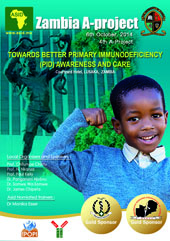Nesrine Radwan, assistant lecturer of pediatrics, faculty of medicine, Ain Shams University, Cairo, Egypt.
Background: HIES is a rare primary immunodeficiency characterized by recurrent eczema, skin abscesses, lung infections, eosinophilia and high serum levels of IgE. Two form of HIES have been described, including an autosomal dominant (AD, or type 1) and an autosomal recessive (AR, or type 2) form. These two forms share overlapping clinical and laboratory features. However, they also exhibit distinct clinical manifestations, courses and outcomes.
AD-HIES, associated with heterozygous mutations in the transcription factor STAT3,and commonly presents with respiratory infections and skin findings including newborn rash, eczema, recurrent skin abscesses and ear, sinus and lung infections resulting in pneumatoceles and mucocutaneous candidiasis. Additional findings include connective tissue and skeletal abnormalities such as a typical facial appearance characteristic of patients with this syndrome, hyper-extensibility of their joints, retained primary teeth and recurrent bone fractures secondary to even minimal trauma. AR-HIES with DOCK8 deficiency who also presents with eczema, skin abscesses, recurrent respiratory infections, candidiasis and other fungal infections. But these patients are liable to have severe, recurrent viral infections caused by pathogens such as Herpes simplex, Herpes zoster and Molluscum contagiosum and liable to allergic and autoimmune manifestations, including food allergy, hemolytic anemia Patients with AR-HIES also have a high frequency of neurologic complications, including encephalitis and vascular brain lesions. The diagnosis of HIES can be made based on a combination of clinical and laboratory findings for both types of HIES. An elevated level of serum IgE is a virtually universal finding in these patients. Decreased serum IgM concentrations and peripheral blood T-cell counts are important laboratory findings of DOCK8 deficiency. An HIES scoring system has been previously developed at the National Institutes of Health (NIH) that can help with the diagnosis of type 1 HIES. In this system, patients are evaluated for the existence and severity of the following clinical and laboratory features: newborn rash, eczema, skin abscesses, recurrent upper respiratory infections, pneumonia, lung changes (cavities), candidiasis, other severe infections, fatal infections, characteristic facial appearance, increased nasal width, high palate, retained primary dentition, joint hyperextensibility, fractures with minor trauma, scoliosis, midline anatomic abnormalities, lymphoma, high serum IgE level, and eosinophilia. The score correlates with the severity of the disease (scores of 0 to 15 unaffected, 16 to 39 possibly affected, 40 to 59 probably affected, and 60 or more definitively affected). The scoring system is a particularly useful tool for the diagnosis of AD-HIES but less so for AR-HIES. Definitive diagnosis can be established with genetic analysis of the STAT3 and/or DOCK8 genes. Therapy of HIES remains largely supportive (Treatment of infection and skin eczema). Antibiotic prophylaxis with trimethoprim-sulfomethoxasole is a frequently used as prophylaxis against recurrent respiratory infections. Poor antibody responses to vaccination in both AD- and AR-HIES lend support to the use of immunoglobulin replacement therapy in those patients. The role of interferon-gamma, granulocyte-colony stimulating factor or other immune modulators in HIES is, however, unproven. Bone marrow transplantation is curative for AR-HIES with DOCK8 deficiency and is recommended given the severity of the disease and the life-long risk of developing fatal complications, including infections, autoimmunity and malignancies
HIES is a rare primary immunodeficiency characterized by recurrent eczema, skin abscesses, lung infections, eosinophilia and high serum levels of IgE. Two form of HIES have been described, including an autosomal dominant (AD, or type 1) and an autosomal recessive (AR, or type 2) form. These two forms share overlapping clinical and laboratory features. However, they also exhibit distinct clinical manifestations, courses and outcomes.



























